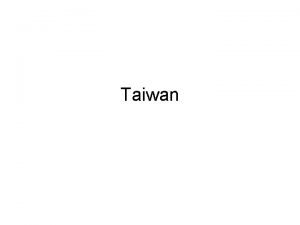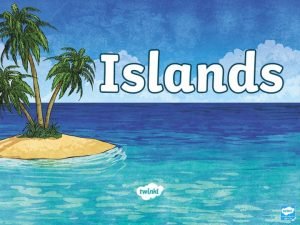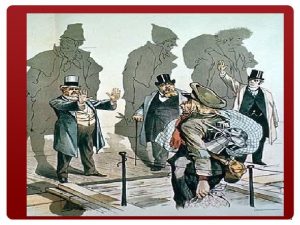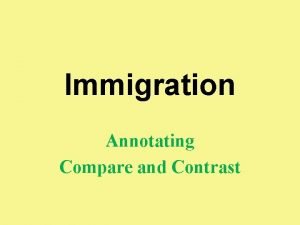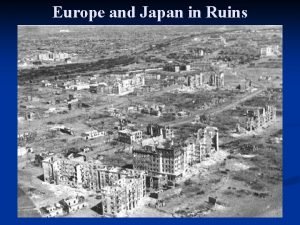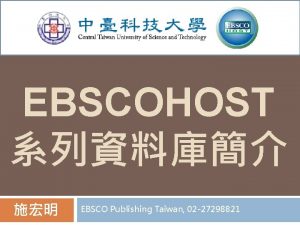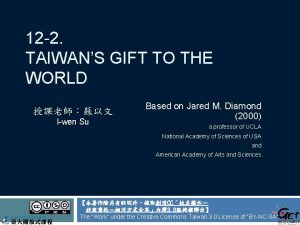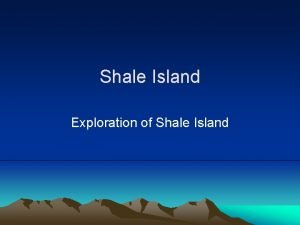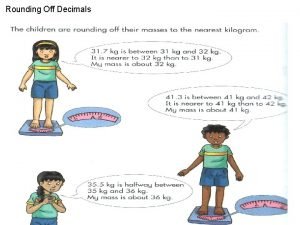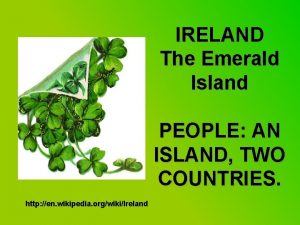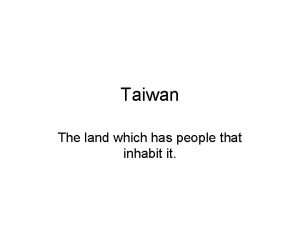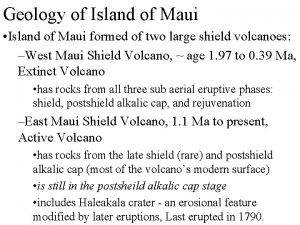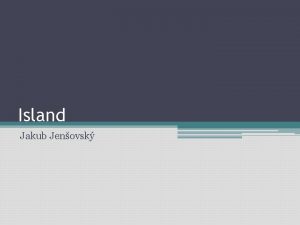I Land People Taiwan Land Taiwan island off


















- Slides: 18


I. Land People: Taiwan • Land. Taiwan island off the southern coast China, just 90 miles away. Its total land area is about 22, 320 square miles, with rugged mountains in east and rolling plains in west as geographical features and tropical and marine as climate features. map


• People. Taiwan has a population of 22 million. The majority of Taiwan's inhabitants are descendants of Chinese who migrated from the southern coast of China in the eighteenth and nineteenth centuries. They claimed themselves as “Taiwanese” which constitute 84% of population. In 1949, when the Communists came to power in mainland China, many Chinese followed the Nationalist government to Taiwan. They are called “mainlanders” and constitute 14% of population. A small group of native inhabitants, which lives in the mountains in central Taiwan, is most likely of Malay -Polynesian origin, constitute 2%.

Geographical Features of the Taiwan Strait • There is a Taiwan Strait located between Fujian Province and Taiwan Province of China and constituted as a critical corridor connecting the East China Sea to the South China Sea. Actually the Strait itself is regarded as part of the East China Sea. map


Geographical Features • The breadth of the northern end is about 93 nautical miles (nm) and that of the southernmost end 116 nm. It is more than 170 nm long and about 60 meters in average depth.

Geographical Features • The Taiwan Strait is one of the important fishing grounds in China, and there about 700 fish species, among which 100 species are economic. • The coastal areas of the Taiwan Strait deposit rich sand reserves. Recently, oil and gas has been discovered around the Taiwan Strait. • In addition, the Taiwan Strait is traditionally used as an important navigational waterway both for China and for the rest of the world. For China, it is a critical sea route from north to south, and also between Taiwan and Fujian Provinces.

Historical and political implications • Historically, the Taiwan Strait was used to be a battlefield. For example, during the year of 1661, Zheng Chenggong led his army across the Strait to recover the Taiwan Islands from the Dutch colonists. • In 1949, the Nationalist government retreated to Taiwan from this strait. The year of 1949 was critical in Chinese history because from this year on, China was divided and two governments have appeared since then. Due to such division, there are two de facto jurisdictions existing within the Strait. The divided status of China has also made the situation in the Taiwan Strait complex and uncertain.

Historical and political implications • During the 1950 s, the situation in the Taiwan Strait was rather intense. The communist regime in the mainland pledged to “liberate” Taiwan. In order to deter the expansion of communism from mainland China to Taiwan and Southeast Asia, the United States was determined to protect Taiwan and sent Fleet 7 to the Taiwan Strait to “neutralize” the Strait. Further, the United States singed a mutual defense treaty with the Nationalist government in Taiwan. • In 1972, the United States changed its policy toward China and normalized its relations with mainland China and declared “One China” policy and peaceful resolution of cross Taiwan Strait confrontation.

Historical and political implications • Taiwan strait could be the most dangerous war zone in East Asia that could bring the United States into it. • In case of armed conflict, Beijing would define a “war zone” in the Taiwan Strait and direct neutral shipping in order to protect its right of innocent passage.

South Korea • Land. South Korea’s total land area is about 38, 013 square miles. The land is mostly hilly and mountainous, but it has wide coastal plains in west and south. The climate features rainfall heaviest in summer. South Korea has a population of 46. 9 million. • People. Korea was first populated by a people or peoples who migrated to the peninsula from the northwestern regions of Asia, some of whom were from parts of northeast China (Manchuria). Koreans are racially and linguistically homogeneous, with no sizable minorities, except for some Chinese (approximately 20, 000).

Geopolitics of the Korean Peninsula • Question: Why is Korean peninsula considered to be strategic location in East Asia?


Geopolitics • The Korean Peninsula, which is in the center of Northeast Asia, had been throughout its history a strategic geopolitical location in which contending powers, China, Japan, and Russia, and other Western powers fought to control. China, as the largest and most technologically and culturally advanced society in East Asia, exerted the most important outside influence on Korea until modern times. • In the latter half of the 19 th century, as the Chinese empire declined and Western powers began to vie for domination in East Asia. Britain, France, and the United States each attempted to “open up” Korea to trade and diplomatic relations in the 1860 s, but the Korean kingdom steadfastly resisted. After defeating China and Russia in wars between 1895 and 1905, Japan became the predominant power on the Korean peninsula.

Geopolitics • In 1910 Japan made Korea as its colony, and for the next 35 years, the Japanese authorities tried to transform Korea’s cultural identity and make Koreans culturally Japanese, going so far in 1939 as to compel Koreans to change their names to Japanese ones. • However, Japan also brought the beginnings of industrial development to Korea. Modern industries such as steel, cement, and chemical plants were set up in Korea during the 1920 s and 1930 s, especially in the northern part of the peninsula where coal and hydroelectric power resources were abundant. By the time Japanese colonial rule ended in August 1945, Korea was the second most industrialized country in Asia after Japan itself.

Geopolitics • In post-WWII, South Korea was separated from North Korea by the United States and the Soviet Union upon the surrender of Japan into two zones of temporary occupation, for the purpose of overseeing the orderly dismantling of Japanese rule and establishing a new Korean government. The United States was to occupy Korea south of the 38 th Parallel of latitude (a demarcation running east and west across the peninsula) while the Soviet Union was to occupy Korea north of that line.

Geopolitics • In the early 1950 s, the United States engaged in a full scale of military confrontation with the Chinese military on the Korean peninsula and it became the major war zone after WWII, which ended with maintaining the division between the north and the south on the 38 th Parallel of latitude. • During the Cold War, the Korean Peninsula became the strategic area for the United States to establish a security blanket against the Soviet Union along the Pacific Rim. After the Cold war, the peninsula has been plagued by the nuclear crisis for a decade without a feasible solution.
 Location goelette taiwan
Location goelette taiwan Island of the blue dolphins map
Island of the blue dolphins map Is an island
Is an island Ellis island vs. angel island
Ellis island vs. angel island Ellis island and angel island venn diagram
Ellis island and angel island venn diagram Elbows off the table fingers off the food song
Elbows off the table fingers off the food song Identify the landform
Identify the landform What are landforms
What are landforms Note three political problems postwar governments
Note three political problems postwar governments Transformed people transform people
Transformed people transform people Justpeople
Justpeople People in media and people as media similarities
People in media and people as media similarities People kill and people dyin
People kill and people dyin Ebsco taiwan
Ebsco taiwan Ptt tw drama
Ptt tw drama Taiwan water corporation
Taiwan water corporation Wei yu taiwan host
Wei yu taiwan host 日本 rìběn
日本 rìběn Taiwan’s gift to the world
Taiwan’s gift to the world
